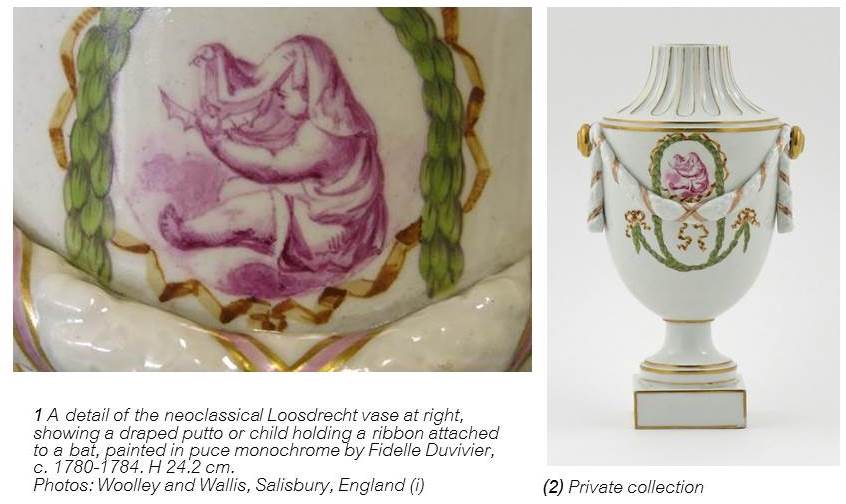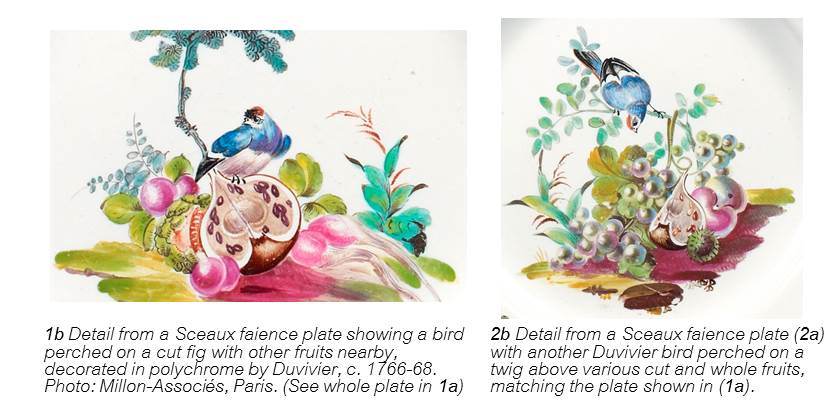
by Charlotte Jacob-Hanson | Sep 30, 2018 | Uncategorized
Not long ago several pictures of this very unusual Loosdrecht vase (auctioned in England in 2014) were sent to me by its present owner. A rare and curious vase, indeed, for its painted decoration, done by Fidelle Duvivier. We see a draped putto or child holding up a ribbon from which a bat hangs with its wings extended. The vase is unmistakably neoclassical in style, but what is the bat meant to signify in this decoration?

by Charlotte Jacob-Hanson | Aug 15, 2018 | Uncategorized
Fidelle Duvivier demonstrated his exceptional gifts for painting cherubs or putti on porcelain throughout his career – both in England and on the Continent (as mentioned in blogpost #13: ‘More Cherubs on Clouds, painted in The Hague’ – Feb. 27, 2018). Examples have been identified at every manufactory where he was employed – at Derby, Sceaux (i), Loosdrecht, on Ansbach porcelain decorated at The Hague (1), with one late example (5) known from the period of his second stay in England, when he worked for the New Hall manufactory, c. 1785-90. Most were painted in puce camaïeu, and some of his finest examples are found on Loosdrecht porcelain, with a new example shown below (3).(ii)

by Charlotte Jacob-Hanson | Jun 24, 2018 | Uncategorized
This colorful pair of birds by Duvivier appears on two twelve-lobed faience plates made at Sceaux. One is perched on cut fruit, while the other hovers on a low twig just over the ground, eyeing delectable fruits spread out below. (The whole plates are shown below in 1a and 2a). Their claws are delicately rendered in black, painted almost like inverted commas. We find a good many examples of Fidelle’s birds on the popular Sceaux dessert plates with the blue “notched” edges, and these creatures are often standing on elevated rocky plateaux (i). But on another such plate appearing at an auction in 2017, Duvivier painted a couple of feathered specimens with similar “black-comma claws,” engaging each other on two kinds of vegetation spread across the plate (3c).

by Charlotte Jacob-Hanson | May 15, 2018 | Uncategorized
The charming Dutch town of Weesp, situated on the river Vecht and just 15 km from central Amsterdam (see map, 10), celebrated its 650th anniversary as a city in 2005. In the centuries after receiving its city rights in 1355, the town developed into an important trading center for ship traffic along the Vechtstreek, that stretch of river extending from Utrecht north towards Amsterdam. If you’re curious about the history of Dutch porcelain in the eighteenth century, this is where the story began, and a visit to Weesp and the municipal museum (now just called Museum Weesp) will give you some rare insights into the story and the production of the first Dutch porcelain manufactory.

by Charlotte Jacob-Hanson | Mar 16, 2018 | Uncategorized
In addition to the example shown in my book (Fig. 1), the Sceaux manufactory made bulb pots in a great variety of shapes in faience, and some of those sold at French auctions in recent years were also decorated by Fidelle Duvivier (Figs. 2, 12), as it turns out.(i) What kinds of bulbs bloomed on these delicate devices and what were they filled with? The answers to these questions take us into the history of the cultivated hyacinth in Europe.

by Charlotte Jacob-Hanson | Feb 27, 2018 | Uncategorized
Fidelle Duvivier decorated porcelain with putti (also variously called cupids or cherubs) at every manufactory where he worked – at Derby, Sceaux, Loosdrecht, and New Hall (1a,b). Most were painted in puce camaïeu, and some of his finest examples are found on Loosdrecht porcelain (as shown in my book). But while in the Netherlands he also painted a few of these ethereal beings on Ansbach porcelain – for the Lyncker family of The Hague.(i)






